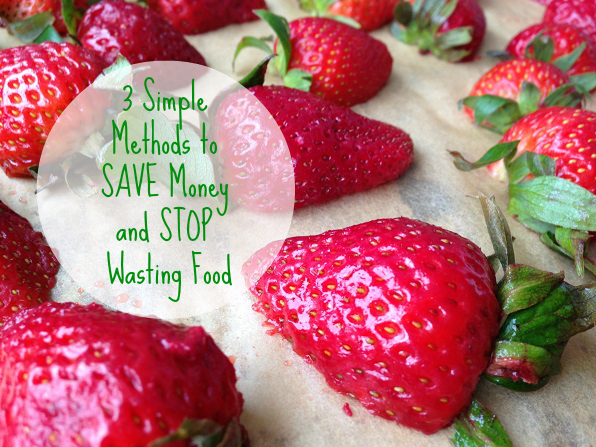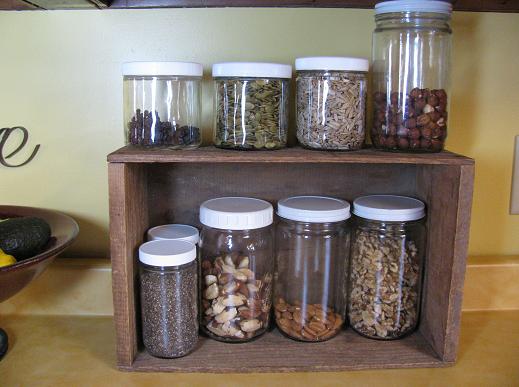The post Simplifying Nature Study appeared first on Day2Day Joys.
]]>*note from Rachel: Kristen first started contributing in May of last year. She’s talked about homeschooling (a topic she loves!), freezing blueberries, organization and more! Today she’ll be sharing her last post here. I’m sad to see her go, she’s on to new endeavors and focusing on her family. I I have been blessed by Kristen and hope you have as well!!
After researching homeschooling options and approaches years before we actually started formal education (yes, I tend to over-research), I knew that I wanted our homeschool to be focused more on hands-on experiences and less on textbooks.
When it comes to science, a hands-on approach often involves nature study. I’m someone who likes to tinker in gardening, foraging, and herbs, so nature study seemed like a great fit for us!
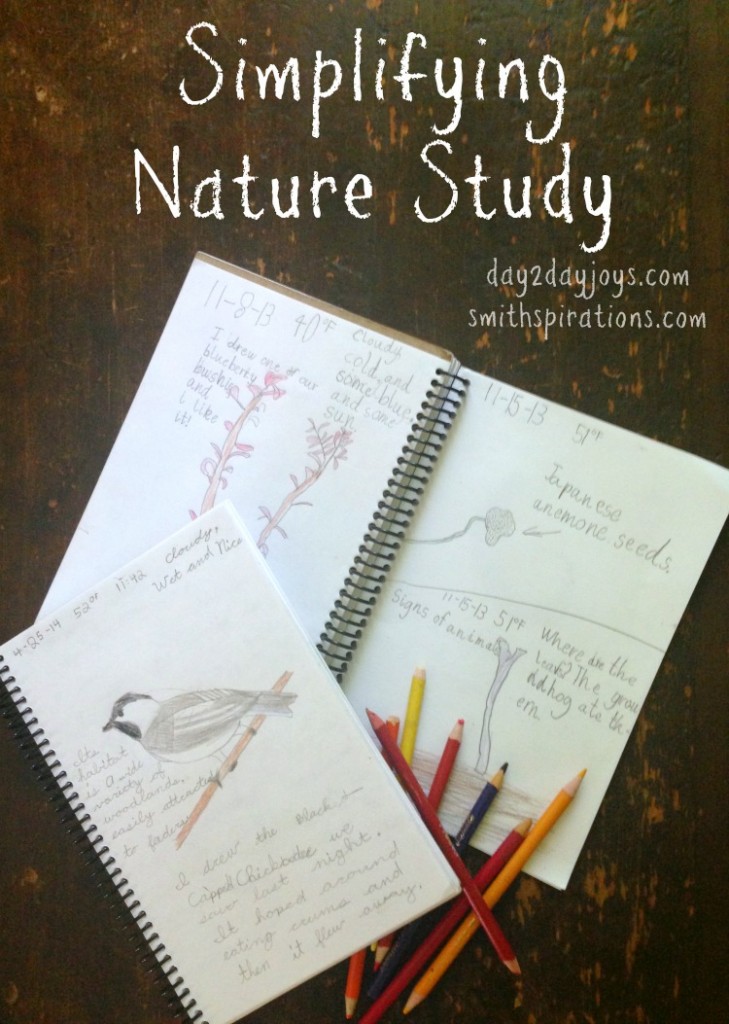
However, during our first couple of homeschooling years, I consistently found myself feeling overwhelmed, lost, and really uncertain with the whole area of nature study. I was never quite sure if I was doing it the right way and our projects took twice as long as I thought they should.
Looking back with a little more experience under my belt, I realize that I made nature study way more complicated than it needed to be.
Nature study can be as simple as spending time outside, finding something interesting, recording it with drawings and words in a notebook, and perhaps researching it later. Sure, you can make it more involved, but if you’re not quite sure how to tackle the whole process, those simple steps are the best place to start.
Whether your children are homeschooled or attend school, adding some nature study to your schedule is a great way to learn about God’s great creation. Keep in mind these following tips to make sure it is an enjoyable experience for you and your children.
Go With The Seasons
The seasons offer us a very simple way to organize our nature study lessons:
- In the winter, we look for animal footprints in the snow or stick with basic science experiments inside.
- In the spring, we study tree buds swelling, signs of the new season starting, and animal tracks left in the mud.
- In the summer, we watch butterflies, birds, and insects in the garden, talk about helpful plants, and identify bird calls.
- In the fall, we compare seed shapes, examine abandoned nests, and do leaf rubbings (of course!).
Let Nature Come to You
While field trips to nature parks, zoos, aquariums, and museums are fantastic ways to enrich nature study, so much can be done in our backyards!
Just a simple walk through the yard offers an abundance of plants to be discovered, and many of them are edible or useful. Clouds can be studied, bird feeders set up, and earthworms unearthed all from the comfort of the backyard. Doing nature study right at home helps keep things simple and doable!
Follow Their Interests
Sometimes I suggest a topic to study for our nature study time and my children are less than thrilled. Rather than make it an area of contention, I ask them for their input based on what is available to us that season.
I also try to keep in mind if something has recently grabbed my children’s interest. For example, when we had a groundhog lurking in our backyard, we did a couple of nature study lessons on groundhogs!
Stocking a Nature Study Tool Chest
You really don’t need many special tools for nature study, but certain materials will make the process more exciting and educational for your children. I like having these simple materials on hand:
- Inexpensive blank spiral sketchbooks serve as nature study journals
- Colored and graphite pencils are used for nature journal entries
- Magnifying glasses help see simple details and are just plain fun to use
- Simple microscopes show smaller details but are easy on the budget
- Binoculars allow us to observe animals up in trees or off in a field
Keep Some Good Nature Guides on Hand
Nature guides are our go-to when doing nature study! In fact, we have a fabric bag that we keep stocked for our nature study time that holds nature study journals, pencils, and a big stack of small nature guides. When we do nature study, the bag comes along, and so much information is right there with us!
My top suggestion for finding nature guides is to check with your state’s department of natural resources. In Ohio, I can write in for free nature study guides sent right to me as a home educator! We rely heavily on these, as well as other resources from the department.
This book (affiliate link) provides a lot of basic information that will apply to most of the Unites States. We also keep it in our handy nature study bag so it’s always with us when we head out.
Take advantage of these summer months with some simple nature study with your children!
Do you do nature study with your children? What tips do you have?
The post Simplifying Nature Study appeared first on Day2Day Joys.
]]>The post Educating Yourself for a Better Birth appeared first on Day2Day Joys.
]]>
Written by Kristen @ Smithspirations, Contributing Writer
Like many moms, I don’t think I’ll ever forget my first pregnancy. My husband and I were young and utterly unprepared for what laid ahead of us! I was finishing up college, he was in his first year teaching, and neither of us gave much thought to preparing for birth.
I decided at some point that I wanted us to go to the childbirth classes held at our local hospital, and my hubby dutifully came along. We listened to the instructor talk about the birth process, potential complications, and likely interventions while wrapping things up with various breathing techniques.
After the class ended, I didn’t feel ready for birth, but at least I felt like I did something to try to prepare for the natural birth I thought I wanted. My husband was far less impressed.
It wasn’t until after my induced & medicated birth that I realized how incredibly unprepared I really was for the birth process, despite my faithful attendance and attention at the hospital class. I realized too late that I needed to do much more to educate myself about the process if I wanted to have a positive birth experience.
When we were expecting the second time, I knew I wanted something different. I didn’t want to be hooked up to all sorts of machines and have an internal fetal monitor inserted into my baby’s scalp unless there was a serious reason for it. I needed to figure out what it took to have an unmedicated birth, and I went to reading! What a difference that made!
Why Educate Yourself For Birth?
 All too often, we are prone to simply take one healthcare provider’s recommendations without asking questions. We tend to forfeit our patient rights and responsibilities and simply go with procedure and protocol when we aren’t armed with information.
All too often, we are prone to simply take one healthcare provider’s recommendations without asking questions. We tend to forfeit our patient rights and responsibilities and simply go with procedure and protocol when we aren’t armed with information.
When we invest the time into educating ourselves about God’s awesome and amazing design for birth, we can trust our bodies to do what they need to do in order to bring forth a new life. Rather than think about pregnancy as a risky condition and our bodies as dysfunctional, we can have confidence in the birthing process.
Sometimes things go differently during birth than we thought they would. Medical intervention is at times crucial to a positive outcome for mom and baby. When we are educated ahead of time, we can ask questions, weigh the risks, and make a more informed choice on suggested procedures.
What To Consider When Educating Yourself
There are so many questions to consider when you are expecting a new baby! This list is by no means exhaustive, but rather a springboard.
For Pregnancy:
- What is an ideal diet for pregnancy?
- What exercises help with common pregnancy complaints?
- What can be done to prepare your body for labor?
- What supplements are most helpful during pregnancy?
For Birth:
- What birth place options are available to you? Home? Birth center? Hospital?
- What pain management options are there? Medication? Water? Music? What risks do they carry?
- What are the benefits and risks of eating and drinking during labor?
- What positions and movements help or hinder labor?
For After Delivery
- What are the risks and benefits of typical newborn procedures, like eye ointment, Vitamin K shots, and Hepatitis B vaccines?
- What are the risks and benefits of circumcision (for boys)?
- What can be done to best facilitate breastfeeding in the early moments after birth?
- What pain relief options are best for afterpains after delivery?
How to Educate Yourself
There are many options when it comes to becoming more informed with pregnancy and birth. Some options will provide more reliable and up to date information than others.
- Online resources can be a great place to start, but be cautious about getting all of your information from the web.
- Books were a great help to me when I started to educate myself. I read books by well-respected and experienced figures in the natural birth world (like Dr. Bradley and Ina May Gaskin) and gained confidence because of it.
- Childbirth classes can be a great experience, too! Though my first class experience was far from beneficial, I later attended one held by my home birth midwife and greatly benefited. Ask the instructor about the class outline to know if it will be a good fit. Local doulas and breastfeeding support groups may also have suggestions.
Did you feel well-educated when you went through labor and delivery? Was there something you read, watched, or attended that helped you feel informed?
The post Educating Yourself for a Better Birth appeared first on Day2Day Joys.
]]>The post Learning to Apologize appeared first on Day2Day Joys.
]]>
Written by Kristen @ Smithspirations, Contributing Writer
Have you ever been hurt by someone and found the hurt worsened because you never received a sincere apology? I’ve been there, and it can be terribly painful. Sometimes what isn’t said after an emotional hurt can do more damage than the original offense.
While we can’t do anything to make other people in our lives learn how to apologize, we can make a commitment to be sincere in our own apologies. I certainly don’t want to leave those that I care about feeling more wounded when I’ve wronged them because I couldn’t humble myself to give a heartfelt apology.
Words to Avoid When Apologizing
Some words and phrases don’t really belong in a sincere apology. They may lessen the hurt of your friend, shift the blame, or justify your mistake.
- “I’m sorry that you feel that way” doesn’t apologize for your mistake, but rather shifts the emphasis to your friend’s feelings. We don’t take responsibility for our mistakes when we use that phrase.
- “I’m sorry, but…” The “but” is the problem. When we add a “but” in, we tend to shift the blame of the conflict on to the other person. Our friend may have a part in a conflict, but that can be best addressed after we’ve fully repented for our own wrongs.
- “Well, I didn’t mean to” could be helpful in the overall apology, but if that is all that is said, it may not convince the one we hurt that we truly regret our mistake. I frequently have to teach my children that they still need to apologize when they do something on accident because someone was hurt. It’s the same for us adults!
- “I don’t think you should feel that way.” Ouch. Just ouch. Hurts are real and we need to acknowledge them when we are at fault.
- “I did this because…” We might want to say this to explain ourselves, but if we don’t first say we are sorry, it might just seem that we are justifying our words or actions without recognizing the hurt they caused.
- “Maybe I shouldn’t have…” is only a halfway admission of a mistake and will probably only seem halfway sincere.
Words to Use in an Apology
Certain words and phrases can be extremely helpful in healing hurts that we have caused, whether intentionally or accidentally. Try some of these the next time you find you have wronged someone. I like to say as many of them as I can remember.
- “I’m sorry that I…” Specific apologies let our friend or family member know that we understand what we did wrong and that we truly care that we hurt them.
- “It was wrong for me to…” Admitting that we were wrong without reservations can be challenging and humbling, but it is so powerful! When someone admits to me that they were wrong, I find it almost impossible to not forgive them.
- “Will you please forgive me?” Saying this shows that we understand our need to be forgiven. We also humble ourselves when we ask for forgiveness, and humility is a very attractive thing.
- “How can I make this right?” Sometimes we need to make amends for our mistakes. If we forgot to do something we said we would, taking care of it the next day might be a good way to make it right.
- “I’ll try not to make this mistake again.” As Christians, we show we are truly sorry for our sins against God by trying to not commit them again. Of course we fall short, but our heart is there. It’s the same when we hurt another person. Telling them that we don’t want to make the same mistake again shows a genuine sincerity.
Years ago I heard that Gary Chapman, the man who wrote The Five Love Languages (affiliate link), wrote a book called The Five Languages of Apology (affiliate link). At first I laughed to myself, wondering how long he’d ride the “five languages train”. Then I looked through the book and saw how much truth was in it. If you find it hard to apologize, his book might help you. His ideas helped me understand what makes up a sincere apology.
Do you find it hard to apologize? Have you been hurt before by an apology you never received? Is there something you need to hear when someone apologizes to you?
The post Learning to Apologize appeared first on Day2Day Joys.
]]>The post Real Food on a Real Budget appeared first on Day2Day Joys.
]]>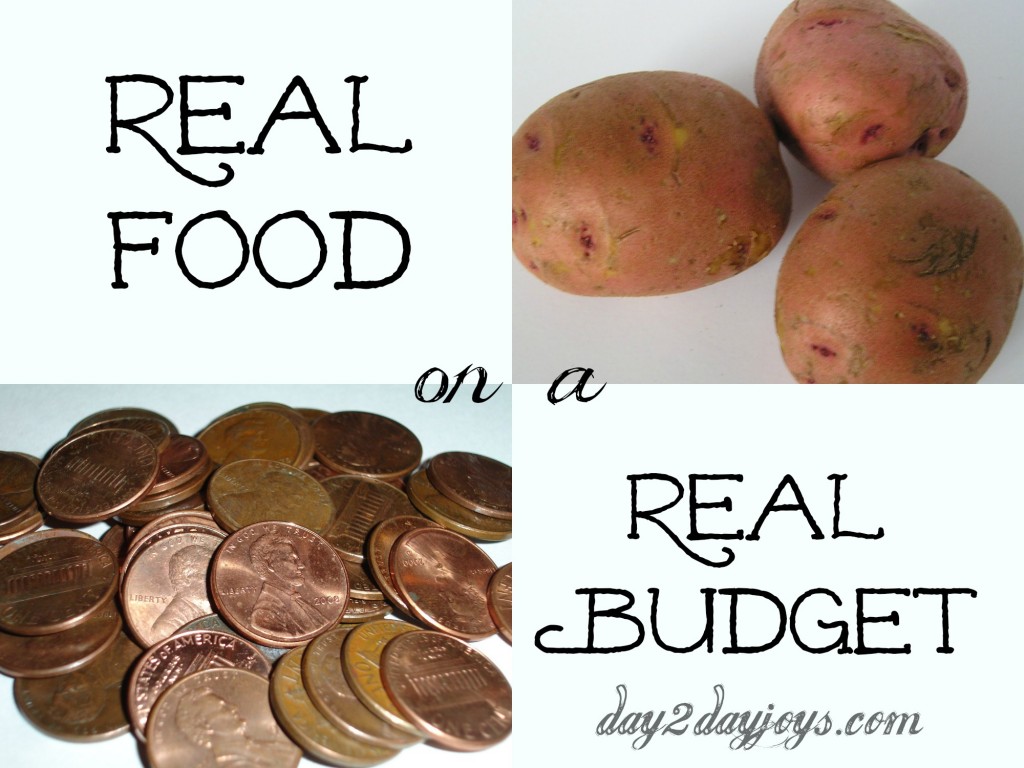
Written by Kristen @ Smithspirations, Contributing Writer
With it being January, you may very well be trying to cut out the processed foods in your diet and take a more whole foods approach to eating. I don’t think anyone denies that eating well is a great way to boost health, but often finances get in the way of making positive changes. Does eating real, whole, healthy foods have to break the bank?
I’m convinced that it doesn’t!
Our family lives on a moderate income. My husband is a public school teacher, and while his salary is far from glamorous, it pays the bills. We have a little bit of supplemental income from a few sources, like my home business, but with our growing family of five children, we have to watch our budget in all areas.
By God’s grace, I’ve found various ways to keep our plates healthy while still keeping our budget in check.
This post contains affiliate links. Purchases made through these links come at no additional cost to you but can bless our family with a small commission. Thank you!
Buy In Bulk
Many foods are suitable for buying in bulk and then storing, drying, canning, or freezing for later.
Berries can be frozen, greens and herbs can be dehydrated, and tomatoes and other fruits can be canned. While the initial cost is a little intimidating, buying a quarter, half, or whole animal for freezer meat is much less expensive per pound, and you can also get more bones for making and freezing broth!
Now that we have a grain mill, I buy our grains for flour in large 25 or 50 pound bags and usually get them for 50 cents to a little over a dollar a pound, depending on the type.
Shop Your Backyard
Gardening can be intimidating, but as long as you approach it with some grace, it can be a wonderful way to cut back on your grocery bill! You’d also be surprised by how many backyard “weeds” are actually very nutritious foods! My children can often be found munching on purslane, sorrel, and chickweed from our yard when we are outside, and I sneak them into salads and cooking, too.
Eat What’s Local
Sometimes it’s easy to get caught up in the latest super foods that have to be purchased from expensive specialty stores. But real food can also be really common food that is easy to find. Check local farmers’ markets during the growing seasons and focus on what is abundant and inexpensive. In the winter time, turn your attention to frugal foods like winter squash, carrots, and the humble potato.
Roll Up Your Sleeves
Packaged and convenience food is always more expensive. A bag of frozen french fries costs more than a bag of potatoes. Doing more of the prep work yourself is a fantastic way to save money even if it does require a little more effort. Enlist your children if they are old enough and share the labor while making fun memories together!
Shop Online
Sometimes one of the best ways to save money is to shop online. Foods that don’t spoil easily, like pastas, rice, and beans can be found online at great discounts! Amazon has a huge grocery selection. For example, I get my organic coffee from Amazon with Subscribe & Save. It ships for free, and I get a discount on the price. Win!
Vitacost is another site I like to check when I’m shopping for foods or household items. (If you’re a first-time customer, you can get $10 off with this link!)
Stretch Meat With Beans and Lentils
Meat is definitely one of the priciest items in our grocery budget, but I believe it is really important to our health! I often make meat stretch a little farther by adding cooked beans or lentils to ground beef and using a whole pound of dried beans with a 3 pound roast to make a bulk batch of taco filling.
Now it’s your turn! What are your best tips to help save money while eating real, healthy food?
The post Real Food on a Real Budget appeared first on Day2Day Joys.
]]>The post Keeping Christ in Christmas, but Not Leaving Him in the Manger appeared first on Day2Day Joys.
]]>
By Kristen @ Smithspirations, Contributing Writer
Around this time of the year, a rallying cry from Christians often has to do with contending for the real meaning of Christmas. We hear and say slogans like “Jesus is the reason for the season” and “Keep Christ in CHRISTmas”, and all with good reason. I admit that I enjoy making homemade gifts, supporting home and small businesses with my purchases, and yes, even scoring a good deal from a big retailer, but all of the buying can take away from a more worshipful mindset if I’m not careful.
With children of my own, I’m much more conscious of this. My husband and I desperately want them to not just think of Christmas as a time to get presents. Of course there’s no escaping that aspect of it in the mind of a child, but we want them to know about the greater meaning. We choose to keep our gift giving modest with three gifts each. We tell them that we give them gifts because we love them, just as God gave the gift of His Son because He loves us.
Last year while opening gifts, we took breaks during the openings to read portions of the Christmas story in the Bible and sing some favorite Christmas hymns. My husband would talk a little bit about the story, perhaps ask some questions, and then we would continue on with a few more gifts. But when all of the opening was finished, we didn’t want to just leave the Christmas story there with the stable, the shepherds, and baby Jesus in the manger.
Jesus in a manger as a newborn baby is a wonderful, miraculous event. All babies are such tiny miracles, but this baby was even more so with all of the supernatural surrounding His birth. Imagine the God of the universe making Himself so humble that He came, as a helpless infant, to lay in a stable with common animals and very common people! It’s really beyond the imagination of man, and deserves all the emphasis we can give it.
However, we also want to use Christmas as an opportunity to take our children on in the story. We wanted to call their minds to remember what they’ve been taught about Jesus.
- Did He stay a baby in a manger?
- What did He do when He grew up?
- How did He save us?
- Is He still dead?
- What can He do for us now?
Yes, we want to keep Christ in Christmas, but we don’t want to leave Him in the manger in the minds of our children. We want them to see that the baby Jesus didn’t stay a baby. He grew, He healed, He taught, and He ultimately saved. We want to use Christmas as an opportunity to draw their hearts to Calvary and on to the day of Pentecost, when the same Holy Spirit that was in Christ came to dwell in the hearts of His followers. And most importantly, we want our children to know that Jesus wants to save them and fill their hearts, just as He did for those first followers.
Charles Wesley, in the famous Christmas Hymn Hark the Herald Angels Sing, put it quite well:
Hail the heav’nly Prince of Peace!
Hail the Son of Righteousness!
Light and life to all He brings,
Ris’n with healing in His wings.
Mild He lays His glory by,
Born that man no more may die.
Born to raise the sons of earth,
Born to give them second birth.
As parents, my husband and I want nothing more than to see our children drawn to the Lord and committed to serving Him. Yes, they need to know the miracle of the Christmas story and of Jesus as an infant in the manger. But more than that, Christmas is a wonderful opportunity to remind them of what Jesus did, not as a baby in a manger, but as the Savior of the world.
How do you emphasize the Christmas story in your family’s traditions? Do you ever talk to your children about Christ’s ministry, sacrifice, or salvation during Christmas?
The post Keeping Christ in Christmas, but Not Leaving Him in the Manger appeared first on Day2Day Joys.
]]>The post Cultivating a Heart of Gratitude in an Unthankful World appeared first on Day2Day Joys.
]]>With Thanksgiving around the corner, many of us turn our hearts towards gratitude. We focus on being thankful for our loved ones, perhaps our home, or the food on our plate. It’s a wonderful time!
However, have you noticed how hard it is to keep that heart of gratitude year round? When turkey, mashed potatoes, and dressing are a thought from the past, it is so easy to get caught up in the unthankfulness of the world! But after all that God has done for us, shouldn’t we do our part to cultivate a heart of gratitude in this unthankful world every day of our lives? I think so!
A Tiny Home and Ma Ingalls
Years ago, I learned a very real lesson in thankfulness and contentment. My husband and I found ourselves stuck in a tiny, two-bedroom house that lost 40% of its value since we bought it. We were expecting our third baby and seemed to see no way out of this teeny piece of real estate. When I looked at our situation, I simply couldn’t believe that God would allow us to be stuck there when my husband and I had dedicated our lives to serving Him!
(Psst. Did you catch that? Yep, I had some pretty wrong thinking. God doesn’t owe us anything!)
Around that time I started doing some gentle homeschooling, and part of it was reading out loud to my children. Having never read Little House on the Prairie, that was one of my first choices, and Ma Ingalls became my hero.
I read about Ma cooking over a fire with a couple of pans. Hauling water from a stream to wash dishes. Making beds in the back of a wagon and laying washed bedding out on the prairie grasses to dry. Wearing the same dress every. single. day.
Then I looked at my closet kitchen and saw hot water that I didn’t have to heat, an oven that didn’t require a fire, and a refrigerator full of perishable foods kept cold. I saw my washing machine and dryer that cleaned my clothes with a turn of a knob. I heard the furnace kick on with no effort on my part.
And I realized that I had been extremely unthankful.
Changing My Thoughts to Thankful Ones
Once I realized how ungrateful I had been, I made efforts to become more thankful.
- When I ran into the open oven door in our small kitchen, I thanked the Lord that I could freely cook and bake without having to start a fire.
- When I felt trapped inside a small house, I thanked Him for plumbing, sanitation, and hot water.
- When I started to wonder if we’d ever get out, I thanked God for the multitude of comforts that our home afforded, like a love seat, warm bed, and bookshelves.
I also realized that I needed to repent for being so ungrateful for the many blessings God had given us in our small home, and also for allowing thoughts of entitlement to take root in my mind. Ma Ingalls woke me up to just how good God had been to us, even in our little house!
Choosing a Heart of Gratitude
In hard times, and sometimes in every day life, it can be a challenge to keep a heart of gratitude. I would guess that for most of us, it does’t come naturally. Rather, by nature, we are selfish and sinful, and we need the Lord to shape our hearts and minds into grateful ones.
How can we cultivate a heart of gratitude in an unthankful world?
- Find something to be thankful for in life’s inconveniences. Stuck in traffic? Thank God for a working vehicle! Appliance break? Thank God for all the times it has worked! Up late with a teething baby? Thank God that your child is otherwise healthy!
- Get a bigger perspective. When we take a step back, many of our first-world problems pale in comparison to the challenges faced by those in less developed countries. How many of us have clean water, working plumbing, ample foods, heated homes, and access to basic medical care? We are incredibly wealthy!
- Put it on paper. Do you know the little song that goes “Count your blessings, name them one by one! Count your blessings, see what God has done!” When I started to list out the innumerable blessings God had given us in our little home, I felt so ashamed tat I had been so ungrateful! Forcing ourselves to recognize the blessings we take for granted can do much to cultivate thankfulness!
Do you find that you have to make efforts to be thankful? Have you learned a lesson in gratefulness like I did?
The post Cultivating a Heart of Gratitude in an Unthankful World appeared first on Day2Day Joys.
]]>The post Organizing the Busy Mom’s Day with Routines Rather Than Schedules appeared first on Day2Day Joys.
]]>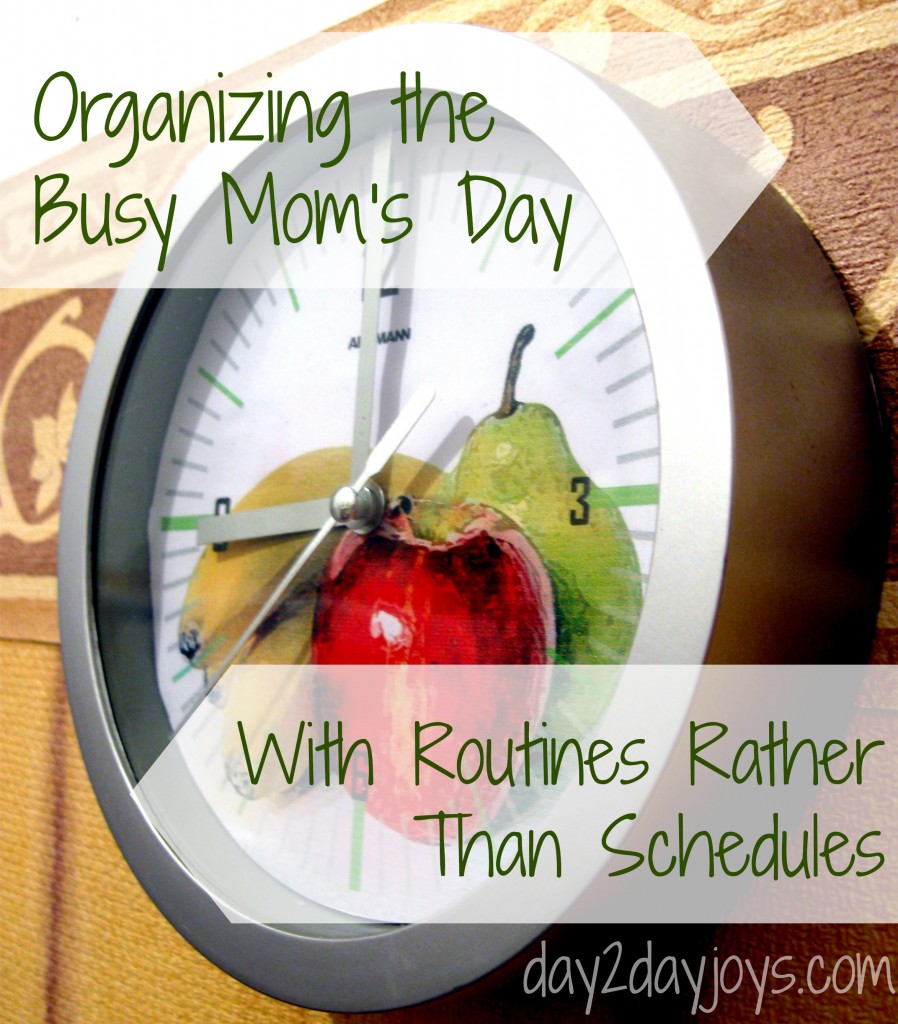
Written by Kristen, Contributing Writer
I like my days to be organized. I like to see a list, check things off, and know that I’ve accomplished the important tasks that need done for my day. If I can get ahead on something, well by golly, I’ll take those bonus points, too! It didn’t take me long, however, to realize that keeping my days organized can be quite challenging when I’m working with a crew of little people. Rather than beat myself up over not sticking with a schedule that is ruled by the clock, I’ve found basic daily routines to be a much better fit for me and my young family.
Why Schedules Don’t Work For Me
I’d honestly really like to get up at the same time every morning, go to bed at the same time every night, finish our homeschooling at the same time every afternoon, and have dinner ready at the same time every evening. But in real life, this just doesn’t happen for me. Why?
Babies keep me up at night, and try as I might, I don’t have the super-power of going on limited sleep for an unlimited time.
Toddlers are really good at throwing multiple curveballs, and sometimes do so with cannon balls. They are cute for a reason, and their uncanny ability to throw a day’s time table off just might be one of them!
Young children still have many needs, and I’m generally the one to meet those needs.
I’ve had to realize that my time is not my own at this stage of my life. I’m constantly setting aside the things I want to do or think I should do to take care of what my children really need for me to do, or maybe just really want me to do. I can either resent that, or work with it. I’ve decided to work with it, and organizing my day with routines instead of schedules helps me with that goal.
Routines and Schedules: What’s the Difference?
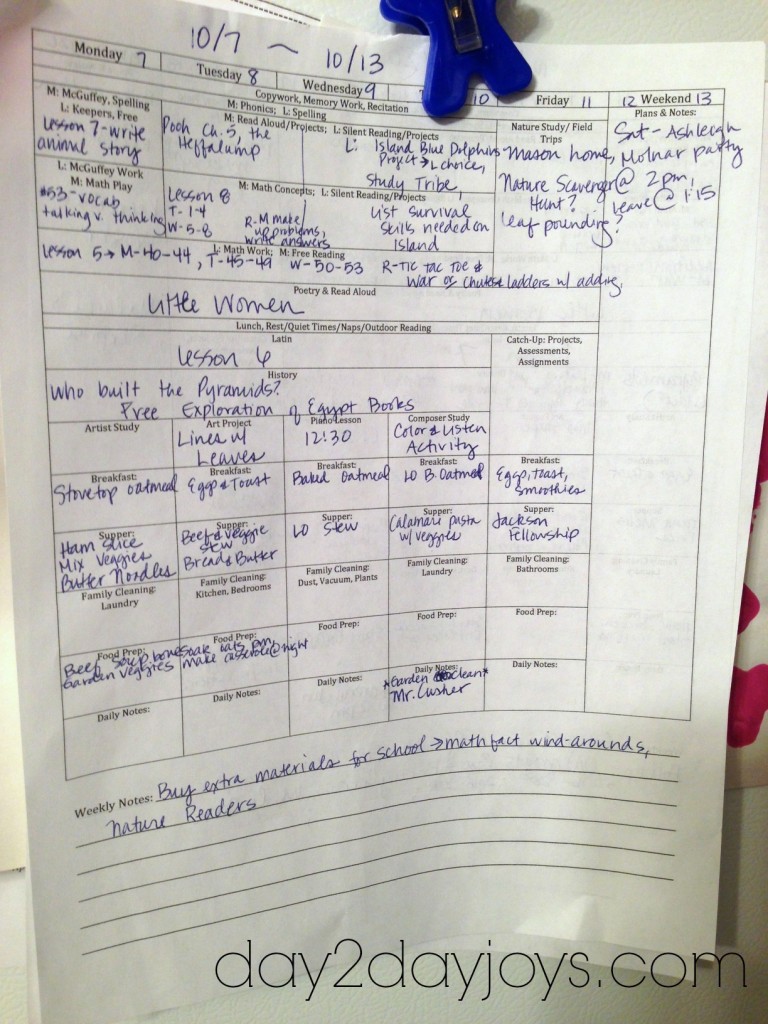
The whole concept of working with daily routines instead of schedules was first introduced to me by a mom of eight at a homeschool convention. Hearing her wisdom and experience for daily living made so much sense to me! Focusing on routine rather than schedule was one thing she really emphasized.
Schedules are run by the clock. We organize our daily activities by the time and work to meet certain deadlines throughout the day. If something isn’t finished during it’s allotted time, we can either panic, put it off for the next day, or make it up during free time.
Routines, on the other hand, allow us the flexibility to follow a typical pattern for each day and to know what is expected without keeping our eye on the clock the whole time. There is still daily accountability, but it’s combined with more freedom and less pressure. As a mom of young children, I’m continually reminded how important flexibility is!
How I Use Routine in My Home
Putting a daily routine into practice for our home has been a great help to our homeschooling days, and just life in general. My children have a good idea of what happens when and I still enjoy a level of freedom to shuffle things around, finish schoolwork whenever we are done, or serve lunch at 2pm instead of noon.
For example, I try to get up around the same time every morning. I’ve found that a key element to fitting everything into my very full homeschooling days. But I’m expecting our fifth child, and sometimes I need extra rest and simply can’t get up when I’d like to. Working with a routine allows me to sleep a little later if I really need it. That does mean our day gets off to a later start, but that’s okay.
This is another common one: the toddler morphs into Baby Destructo. Maybe it’s scrambled eggs and smoothie spilled all over the carpet again. Or maybe she dumped out multiple puzzles while I was busy somewhere else. Or perhaps she snuck into the lazy Susan in the kitchen and poured oats out all over the floor. (They’re cute for a reason, remember?) Working with a routine keeps me from fretting any more than I already am because I’m not staring at the clock and thinking about how far behind I’m getting with my day.
Truthfully, I do still watch the clock with our daily routines. I still like finishing school around the same time and having our family dinner at a consistent time. But I also try to give myself, and my children, grace to not be a slave to the ticking face on the wall.
Do you find it hard to run your day according to a strict schedule? Or are you opposite, finding schedules to work best for your family?
The post Organizing the Busy Mom’s Day with Routines Rather Than Schedules appeared first on Day2Day Joys.
]]>The post Dehydrating Greens for Easy Nutrition All Winter Long appeared first on Day2Day Joys.
]]>
Written by Kristen, Contributing Writer
This has not been the grandest year for my garden. There’s no abundance of tomatoes to can, no peppers to freeze, and hardly enough basil to make one batch of pesto, but I decided to give myself grace with gardening and not aim for perfection. I’ve realized that even in an off-year with the garden, certain crops always do well.
One of those for us is Swiss chard, and I’ve got more than our family cares to eat. In the past I would lightly steam and freeze it to use in place of frozen spinach in recipes, but it rarely would get completely used up, and I’d rather save the freezer space for something else, like blueberries. I still hate to see it just sit in the garden, though!
The Dehydrator to the Rescue!
My husband really blessed me this year with an Excalibur food dehydrator (Amazon affiliate link), and it’s been a lifesaver when it comes to preserving food with little time and effort from me. After doing lots of peaches, herbs, and some tomatoes, it dawned on me that I should dehydrate the chard for the winter!
Dehydrated chard (or other similar greens) can be added to soups, pastas, breads, smoothies, and more. They take up very little room in the pantry and can quickly add a boost of nutrition to any recipe. Leafy greens are famous for their high content of vitamins and minerals, and having them on-the-ready will be a great help to me this winter and early spring!
How to Dehydrate Chard
The steps to dehydrate chard are so easy! These steps leave you with a dried chard that could still be considered raw. Some people feel that chard and other dark leafies should always be eaten cooked to diminish the oxalic acid in them that can act as an anti-nutrient. If you are concerned about oxalic acid or think that you’ll use your dehydrated greens mostly in smoothies, you can lightly steam the leaves before dehydrating them. I don’t think this will be our primary use, so I dehydrated them raw.
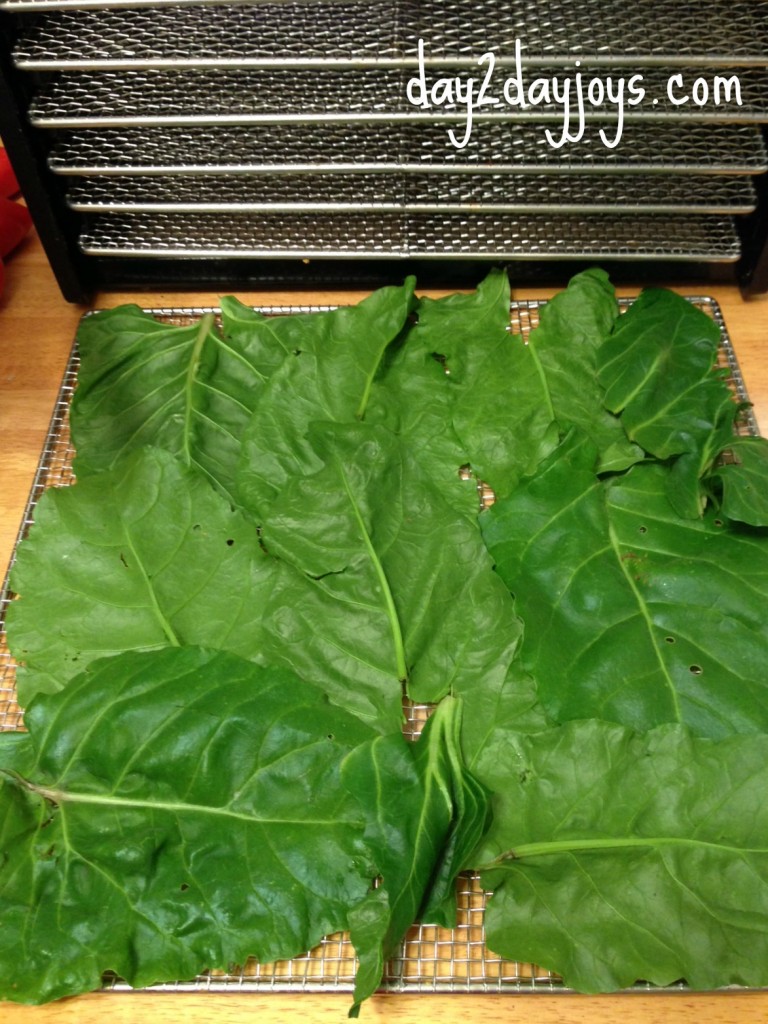
1. Remove the thick stems and veins, and wash the leaves so that they are free of grit. Remove any discolored leaves or sections. (If you want to dehydrate the stems, you certainly can. Just slice them into smaller pieces and expect them to take longer than the leaves.)
2. Lay the leaves on the dehydrator tray in a single layer. A little overlapping is fine, but too much will cause them to dry unevenly and too slowly.
3. Fill up all of the trays, or lay out all of the leaves that you have, and dehydrate the leaves according to your machine’s directions. In my dehydrator, the chard leaves take longer than green herbs, but less time than juicy fruits or vegetables.
4. Once the leaves are completely dry, place them in a food processor. Pulse it to crumble the leaves uniformly.
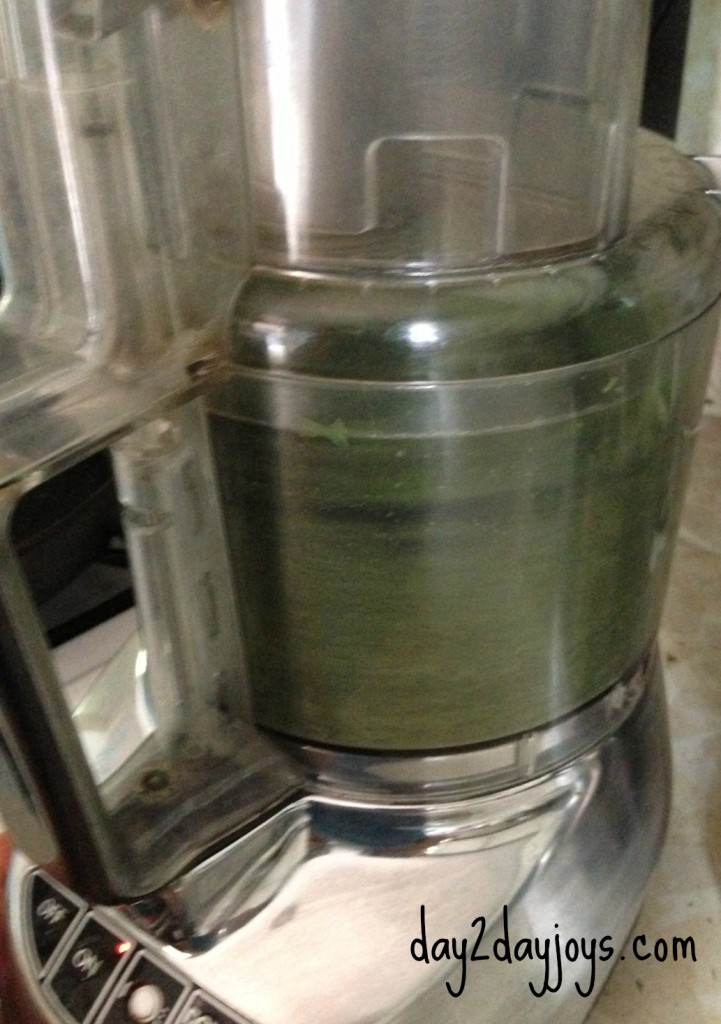
5. Store the dried and crumbled leaves in an airtight container. I prefer glass jars, but plastic freezer bags work as well.
Ta-da! You can now enjoy chard all through the cold winter and early spring months.
It’s amazing how one giant grocery bag filled with chard can be dehydrated down to a quart-sized jar of dried chard! I’m imagining soups, baked pastas, and green tortillas all made with our dried chard.
Have you ever dehydrated greens before, or do you like to freeze them? Is there another veggie that you like to dehydrate for easy food storage? Do share!
*this post is linked to: Encourage One Another, Titus 2sdays, and WFMW*
The post Dehydrating Greens for Easy Nutrition All Winter Long appeared first on Day2Day Joys.
]]>The post Saving Money in Your Budget by Using More Cloth & Less Paper appeared first on Day2Day Joys.
]]>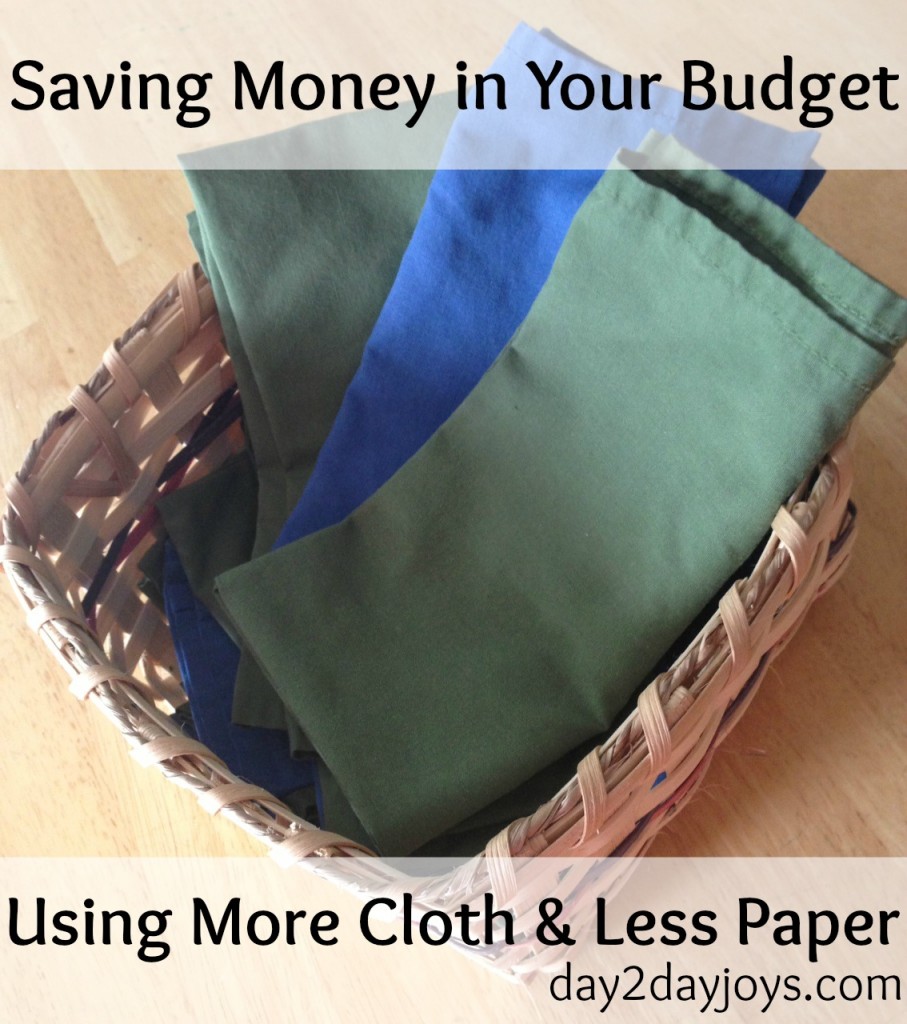
Written by Kristen, Contributing Writer
I don’t know of a single family, and especially those with young children, that isn’t looking to save money in one way or another. Sticking with a family budget isn’t always easy, especially with a growing crew of little ones! One area that is continually a challenge is the grocery bill. We have to eat, and we want to eat well for the sake of our health, but the cost of a whole foods diet can sometimes hurt.
Rather than cutting out important healthy foods, have you ever thought about cutting out some of the disposable paper products you buy on your trips to the grocery store to make your budget more manageable? It can save you a surprising amount of money without really creating a lot of extra work! Let me share some ideas.
Switching from Paper to Cloth
This section contains an affiliate link. Purchasing through the link comes at no additional cost to you and may give the author a small commission. Thanks!

Most of us, when we hear about switching to cloth, will inevitably think of diapers, especially if we have a little one in them! But there are so many other places in our home where cloth can easily be used and washed instead of something else that is used and then thrown away. For instance, have you ever thought about using:
- Cloth napkins? We switched to cloth napkins a couple of years ago after it finally dawned on me that it was silly to continually throw paper ones away. We just bought inexpensive ones from a big box store and usually throw them in with the laundry at the end of the day. You can also use washcloths as cloth napkins, turn inexpensive flat sheets into beautiful stenciled napkins, and make cloth napkins a meaningful family tradition.
- Cloth cleaning rags? Paper towels quickly add up, especially when you use them to clean in the kitchen and bathroom. I’ve found that cotton rags and cleaning cloths work just as well as any paper towel! Old cotton t-shirts, hole-y or mismatched cotton socks, and worn out cloth diapers make great cleaning cloths, and they are free!
- Cloth diapers and baby wipes? For years I was totally intimidated by the idea of cloth diapering until a friend told me how much it had changed since my mom’s generation and how many user-friendly options there are today. Now I can’t believe it took me so long to give up disposables! Cloth diapers and cloth wipes are so simple to use and so economical. It’s estimated that a family can save $2,000 or more per diapered child just by using cloth! Check out Confessions of a Cloth Diaper Convert (affiliate link) if you are still on the fence. It’s a super resource!
- Cloth “tissues”? I always remember my dad and grandfathers carrying around a “hankie” (usually a folded up red or blue bandana) in their back pockets to use as a tissue during the day. While we still mainly stick with boxes of paper tissues in our house, I’ve definitely seen cloth alternatives at work!
- Cloth feminine pads? This is another option that I haven’t tried myself yet, but plan to after our baby is born. Disposable pads are often made with all sorts of bleaching chemicals, and I don’t like to think of those next to my most delicate skin. Cloth pads save money in the end and avoid the toxins, too. Read what Paula of Whole Intentions has to say about the benefits of cloth pads.
- Family cloth? Here’s one that simply won’t happen in most households, and truly, that’s okay! Family cloth is a polite way of describing the cloth alternative to toilet paper. Our family hasn’t gone that route, and I doubt we ever will, but my blogging friend Anjanette wrote a very convincing case for it!
How Much Will You Save?

The exact amount saved from your budget will obviously depend on lots of factors. How extensively you use your paper products, how large your family is, and general lifestyle habits will all play into the savings. For our family, we’ve saved a tremendous amount of money by not buying disposable diapers for the last four years. With another baby on the way (our third in cloth), the savings continue to add! I can’t remember the last time I bought paper towels, and the only time we buy paper napkins or plates is when we are hosting a birthday party or recovering from a new baby addition. The savings have been very real to us!
But that’s not all. Our small town recently updated how they handle trash pick-up, and my husband and I discovered that we can pay by the bag. Since we use so little disposable products and practice composting and recycling extensively, we were able to drop our trash bill from $20-$25 per month down to about $3-5 per month!
But Is the Extra Work Worth It?
That’s a legitimate question. Frugality can be taken to such an extreme that the blessings of convenience are ignored. For our family, we’ve found that using cloth in place of most disposable paper products adds an additional two to three loads of laundry a week, with most of that being diapers. Cloth napkins and cleaning rags don’t even make up a load themselves! Our children are in charge of folding most of the laundry, and these cloth items are usually the job of our four-year-old. Preschoolers can easily handle folding cloth napkins and diapers, and our daughter usually gets a great deal of satisfaction from completing this job by herself.
Of course there are times when it makes sense to just use some disposable items: parties, welcoming a new baby, periods of family sickness, or times of over-commitment. But for the most part, I’ve found cloth alternatives to many paper products to be a fantastic way for our family to save money without working too hard!
Do you use some of these cloth alternatives to paper products in your family? How has is worked for you? Or is the thought of less paper and more laundry totally overwhelming? I’d love to hear your thoughts!
The post Saving Money in Your Budget by Using More Cloth & Less Paper appeared first on Day2Day Joys.
]]>The post The Easiest Way to Freeze Blueberries appeared first on Day2Day Joys.
]]>
Written by Kristen, Contributing Writer
It’s Blueberry Season!
It’s hard to beat fresh, seasonal berries, especially when you have access to local fruits that you can even pick yourself. The flavor can’t be beat! They are so sweet, so tasty, and sadly, so temporary. Berries aren’t known to have a long shelf-life!
One of my favorite things to do in July is to buy blueberries in bulk from a local farm market. They aren’t grown there, so these berries aren’t quite as fresh as the you-pick varieties we can find at the orchards around us. But this busy mom has limits, and she really likes having the convenience of 10 pound boxes of bulk blueberries!
I put these blueberries in smoothies, oatmeal, desserts, muffins, and more. With all of those uses, I’ve found that 40 pounds is a good amount to get us through the year. While it is much more convenient to buy so many blueberries already picked than to try to do the labor myself, I do come home from the store with an awful lot of blueberries to freeze at once.
The Typical Routine for Freezing Berries
The typical routine for freezing berries is pretty much the same regardless of where you look:
- Wash and sort berries.
- Remove stems and hulls (if they have them) and cut up large berries, like strawberries, if desired.
- Lay on a cookie sheet or pan in a single layer and place in the freezer for a few hours or overnight.
- Once frozen, transfer the berries to a freezer bag that has been labeled with the berry name and date.
- Keep the berries in a deep freezer for long term storage.
It’s not hard. It’s not exactly time-consuming. But when you have 40 pounds of blueberries to freeze, finding enough cookie sheets and pans to stick in the freezer, and enough freezer space to lay them on, is a bit of a challenge. This year I was especially pressed for time, and I didn’t want to have many of my precious seasonal berries end up in the compost! I decided there must be a better way, and there is!
The Easiest Way to Freeze Blueberries

Now, this slacker simplified way of freezing blueberries will only work for blueberries. Don’t try it with strawberries or raspberries. If you have blueberry cousins to freeze, like saskatoons, this might work for them, too, but I’m not sure.
The steps really can’t be easier:
- Wash blueberries in a large colander, then gently shake to remove excess water.
- Dump the berries into a 9×13 baking dish lined with a kitchen towel, filling about 1/3 or 1/2 of the way.
- Gently shake the pan from side to side to shake off more of the water drops and pick out any smashed, squishy, or otherwise bad berries.
- Dump the berries into a heavy-duty freezer bag (labeled with the date and berry name if you want), filling about 2/3 of the way.
- Lay the bag flat in the freezer, spreading the berries out evenly in the bag. After they’ve frozen in the bags completely, move the berries around inside the bag to break up any clumps.
- Keep them in a deep freezer for the best results, and if you are freezing 40 pounds of berries like me, you probably need that extra freezer space.
Voila! Removing that extra cookie sheet step allowed me to quickly get all of those blueberries in the freezer in only an hour or two instead of many hours and lots of waiting over a few days.
You’re probably wondering if the berries aren’t just one giant frozen clump inside of the freezer bags. I’m very glad to announce that blueberries have some sort of magical power that prevents them from freezing together. There’s probably some rational reason for it, but I don’t know what it is. Also, since your berries may be a little damp when you put them in, you might find some extra ice crystals in the freezer bag. This doesn’t bother me, but if it does you, you can try to more thoroughly dry the berries before bagging them.
There may still be some merit in freezing the berries on a cookie sheet first. I’m not sure, but I’ll find out as the winter goes on and I pull out my freezer bags of berries. I have a feeling that any slight disadvantages will pale in comparison with the time and effort this simplified method just saved me, though!
Do you freeze blueberries in the summer? Have you ever tried just putting them in a freezer bag, or do you use some other method?
The post The Easiest Way to Freeze Blueberries appeared first on Day2Day Joys.
]]>















